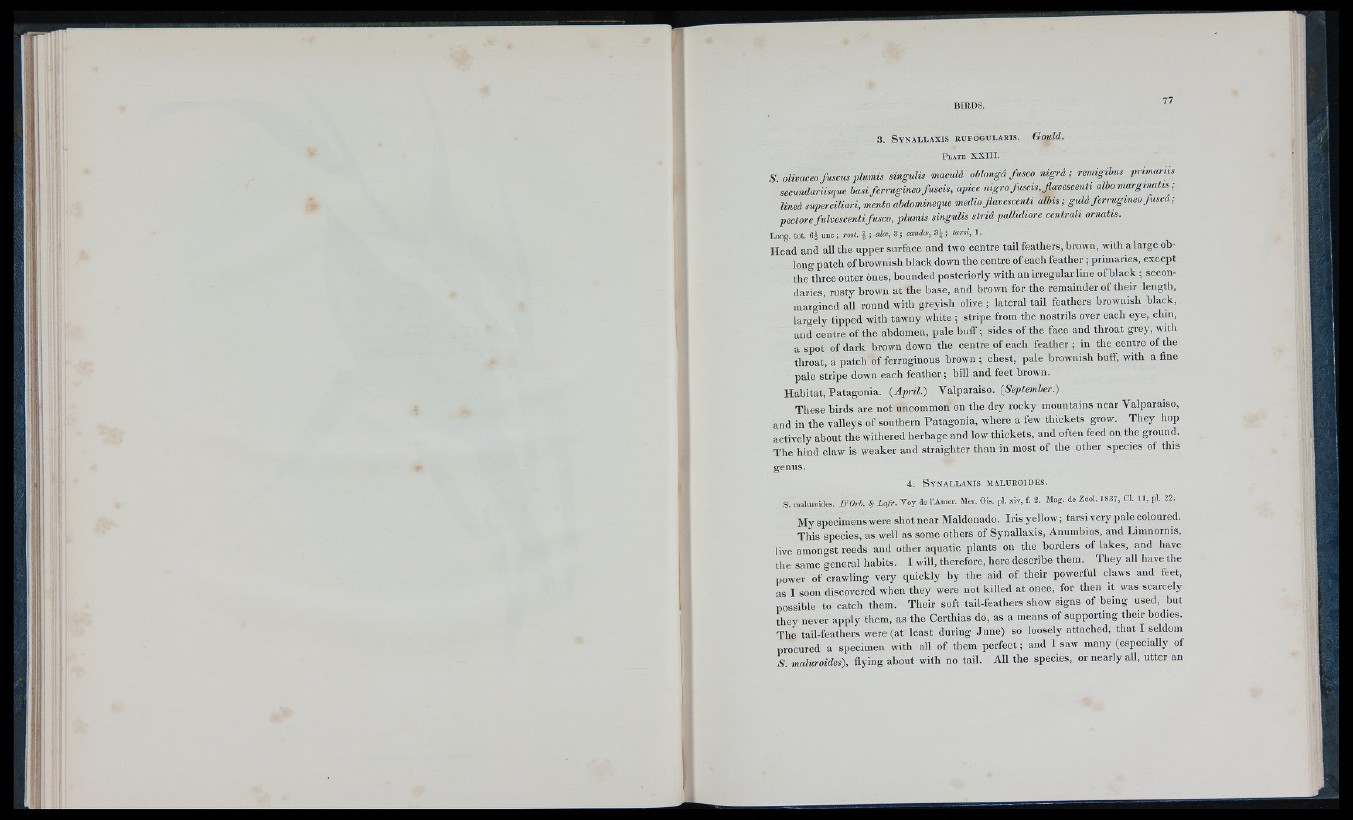
3 . S y n a l l a x i s r u f o g u l a r i s . Gould.
P l a t e X X I II.
s . oliváceo fuscus plumis singulis macuU oblongá fusco nigrá ; remigibus primariis
secundariisque basiferrugineo fuscis, apice nigro fuscis, fiavescenti albo margmatisj
lined superciliaH, mento abdomineque medio fiavescenti albis ; guU ferrugineo fusca ;
pectore fulvescentifusco, plumis singulis strid pallidiore centrait ornatis.
Long. tot. Hi unc ; roH. i ; aloe, 3 ; caudæ, S i ; tarsi, ].
Head and all the upper surface and two centre tail feathers, brown, with a large oblong
patch of brownish black down the centre of each feather ; primaries, except
the three outer ones, bounded posteriorly with an irregular line of black ; secondaries,
rusty brown at the base, and brown for the remainder of their length,
margilied all round with greyish olive ; lateral tail feathers brownish black,
largely tipped with tawny white ; stripe from the nostrils over each eye, chin,
and centre of the abdomen, pale buff; sides of the face and throat grey, witli
a spot of dark brown down the centre of each feather ; in the centre of the
throat, a patch of ferruginous brown ; chest, pale brownish huff, with a fine
pale stripe down each feather ; bill and feet brown.
Habitat, Patagonia. (April.) Valparaiso. (September.)
These birds are not uncommon on the dry rocky mountains near Valparaiso,
and in the valleys of southern Patagonia, where a few thickets grow. They hop
actively about the withered herbage and low thickets, and often feed on the ground.
The hind claw is weaker and straighter than in most of the other species of tins
genus.
4 . S y n a l l a x i s m a l u r o i d e s .
s. maluroidoB. D'Orb. Lafr. Toy de VAmer. Mer. Ois. pi. xiv, t. 2. Mag. de Zool. 1837, 01. 11, pi. 22.
My specimenswere shot near Maldonado. Iris yellow ; tarsi very pale coloured.
This species, as well as some others of Synallaxis, Anumbius, and Limnornis,
live amongst reeds and other aquatic plants on the borders of lakes, and have
tlie same general habits. I will, therefore, here describe them. They all have the
power of crawling very quickly by the aid of their powerful claws and feet,
as I soon discovered when they were not killed at once, for then it was scarcely
possilde to catch them. Their soft tail-feathers show signs of being used, but
they never apply them, as the Certhias do, as a means of supporting their bodies.
Tlie tail-feathers were (at least during June) so loosely attached, that I seldom
procured a specimen with all of them perfect ; and 1 saw many (especially of
A maluroides), flying about with no tail. All the species, or nearly all, utter an